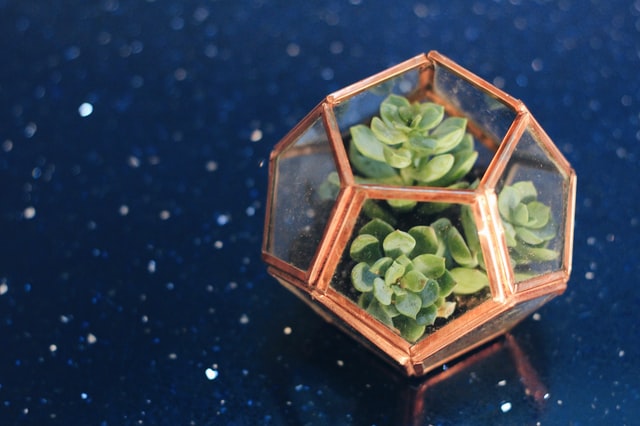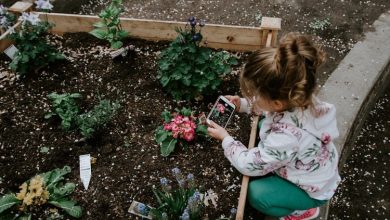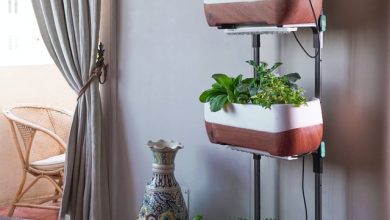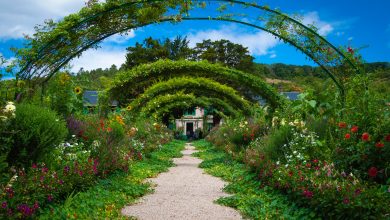How to Make a Closed Terrarium

When you want an efficient and great looking way to grow your favorite plants indoors, a closed terrarium can provide a great solution. While many plants and flowers can easily be grown inside, your home’s indoor atmosphere isn’t always ideal. Things like kitchen heat, HVAC systems, indoor humidity, and more can easily deter a plant from reaching optimal growth inside your home.
Through making your own terrarium, you have a unique opportunity to exercise more control over how your plants and flowers grow indoors. Terrariums also make for excellent home decor pieces. In this article, we’ll detail what closed terrariums are and how you can easily make one of your own.

What Are Closed Terrariums?
At its core, the goal of a closed terrarium is to create a tiny ecosystem within your home that can help your plants grow and thrive. Closed terrariums can be made in many different sizes, but virtually all of them require the tops and sides of the container to be made of glass in order to direct sunlight inside.
Once your plants and soil are inside the terrarium, the magic (or science, rather) begins to happen. Here’s a rundown of how a terrarium ecosystem works:
- Plants, soil, and water are added to the base of a glassed-in terrarium.
- Heat and light from the sun are drawn in through the terrarium’s glass.
- Moisture from the soil and plant combine with the incoming light and heat to promote a continuously generating water source.
Once the terrarium’s ecosystem process has been established, you’ll find that you hardly have to do anything at all to care for the plants inside.
What Are the Benefits of Growing Plants in Closed Terrariums?
Besides ease of maintenance and care, closed terrariums offer multiple other benefits that can allow for extraordinary gardening indoors. Here’s a look at why closed terrariums are an excellent growing choice for many gardeners:
- Space Saving – For gardeners with little-to-no outdoor gardening space, closed terrariums can be an excellent alternative. Terrariums can be made in all shapes and sizes, allowing for gardeners to design the option that works best for their unique space.
- Creativity – Gardeners genuinely have the capability to unleash their creativity through closed terrariums. Terrariums can be built using a large variety of items and can take the shape and size that the gardener desires. There are practically no restrictions on how this indoor gardening space can be built.
- Year-Round Gardening – Often, gardeners are limited by seasonal weather changes. However, with terrariums, there is no limit for when and how long your plants and flowers can grow. Your plants can thrive in their personal indoor ecosystem year-round.
- Enhanced Planting Options – Some plants grow and thrive in certain climates and environments over others. Through growing in a closed terrarium, many plants and flowers that you might otherwise not be able to grow can thrive.

What Plants and Flowers Grow Best In Terrariums?
While a large variety of plants and flowers can be grown in terrariums, there are certain plant types that thrive better than most in this gardening environment. Here’s a look at some plant and flower options that are well-suited for life in a closed terrarium:
- Button Ferns – Button ferns are very popular with closed terrarium gardeners. These plants are particularly low-maintenance and require very little light, almost preferring shade over other lighting conditions.
- Peperomia – This sometimes flowering plant can thrive in a wide range of light options and requires virtually no maintenance. The peperomia is a perfect choice for closed terrarium gardeners looking for minimal-to-no gardening work needs.
- Polka Dot Plant – Many gardeners enjoy the pink and green colors that are standard of the polka dot plant. While this plant does thrive on bright light, it’s not required to be directly on the plant; this means you can typically grow this plant anywhere within a well-lit room.
- Artillery Fern – With artillery ferns, medium to bright light is best. This lush green plant doesn’t require much care or maintenance.
- Aluminum Plant – Aluminum plants don’t require much light and are easy to establish in a terrarium due to the simple root structure.
- Pileas – Pileas plants thrive in humid environments, making them a perfect addition to any closed terrarium. Medium lighting works best for this plant.
- Moss – All sorts of moss varieties can be grown in closed indoor terrariums. Moss thrives in humid environments and prefers darker lighting, making it the perfect choice for almost any closed terrarium option.
- English Ivy – English ivy is another plant option that doesn’t require much light and does well in warm and moist conditions; this makes it a perfect choice for a closed terrarium.
- Miniature Phalaenopsis Orchids – If you’re looking for an excellent blooming flower to grow indoors, the miniature phalaenopsis orchid is a great choice. This pretty flower requires very little light to thrive and loves a lot of warm humidity.
- Golden Pothos – With regular pruning, golden pothos plants can easily grow and thrive in a closed terrarium. This plant has very moderate light and watering needs.
Many gardeners will select a combination of the flowers and plants above to place in their terrariums instead of sticking to just one kind. By including a variety of plant species in your terrarium, you can create a stunning and lush environment that compliments any indoor space.

How You Can Build Your Own Terrarium
If you’re ready to build your own closed terrarium, you’ll be thrilled at how easy the process is. While we are going to provide basic instructions below to craft your own, keep in mind that closed terrariums offer the unique option of creative liberty; feel free to make tweaks and changes as you see fit along the way!
- First, you’ll need to choose your terrarium container. You can use a wide variety of container types, such as mason jars, fish tanks, glass cookie jars, apothecary jars, and more.
- Place a one-inch layer of pebbles on the inside base of your closed terrarium. By doing this, you create a drainage system for your terrarium.
- Next, add a one-inch layer of activated charcoal on top of your pebble layer. The charcoal will help filter the air in your closed terrarium.
- Using potting soil, add a one-inch layer on top of the charcoal and pebble layers.
- Designate your plant’s spots and plant them accordingly. Be sure to allow each plant enough space to establish roots i.e., don’t plant them on top of each other.
- Add water to the soil of your terrarium, but be sure not to overwater. While the plants in your new closed garden need a healthy dose of water, they don’t need a lot to start.
- Place the lid on your terrarium and station it in a sunlit area in accordance with your plant’s needs.
- Water your terrarium as needed until it establishes its ecosystem and own watering system.
Pro Tips
Whether you’re a novice terrarium gardener or you’ve planted this way before, we’ve got some pro tips that can help you establish and grow the best closed terrarium possible. Take a look below:
- If you notice too much moisture accumulating on the glass’s interior, allow the container to remain open for a short period of time so some moisture can evaporate. It’s vital that the terrarium has plenty of moisture, but too much can cause the plants to become over-saturated.
- When watering the plants in your terrarium, water in very small increments to avoid over-watering. Using a device such as a syringe or a dropper can be helpful in the closed terrarium watering process.
- Monitor the pebbles in your terrarium closely as they can be a great indicator of the watering conditions inside. For instance, if you see water pooled at the bottom of your pebbles, you most likely have too much water in your terrarium and should reduce efforts in this area.
- If choosing to use fertilizer to promote better or rapid growth for your terrarium plants, don’t use a mixture that’s too rich. Instead, try a basic plant food that’s intended for use with most houseplants.
- Don’t use tap water to water your terrarium plants. The chlorine and other minerals found in tap water are not generally conducive to optimal growth for your indoor plants.
- Be sure to monitor overgrowth in your closed terrarium. Many of the plants that are suited best for terrarium living also have a tendency to grow rapidly. You want to avoid plants overgrowing and crowding other plants out or growth occurring outside of your terrarium.
- Closely monitor how much light your closed terrarium is getting. For the terrarium ecosystem to be adequately established, just the right amount of sunlight is needed. For guidance on where to place the terrarium in your home, look to the lighting requirements of your plants.
- Don’t place a limit on the creativity you exert in the construction of your closed terrarium. This form of gardening truly allows you to build a dream garden within your home. Terrarium gardeners have been known to use a variety of glass jars and vases, coffee pots, candle holders, cake stands, fish bowls, food jars, and more to construct their gardens.



